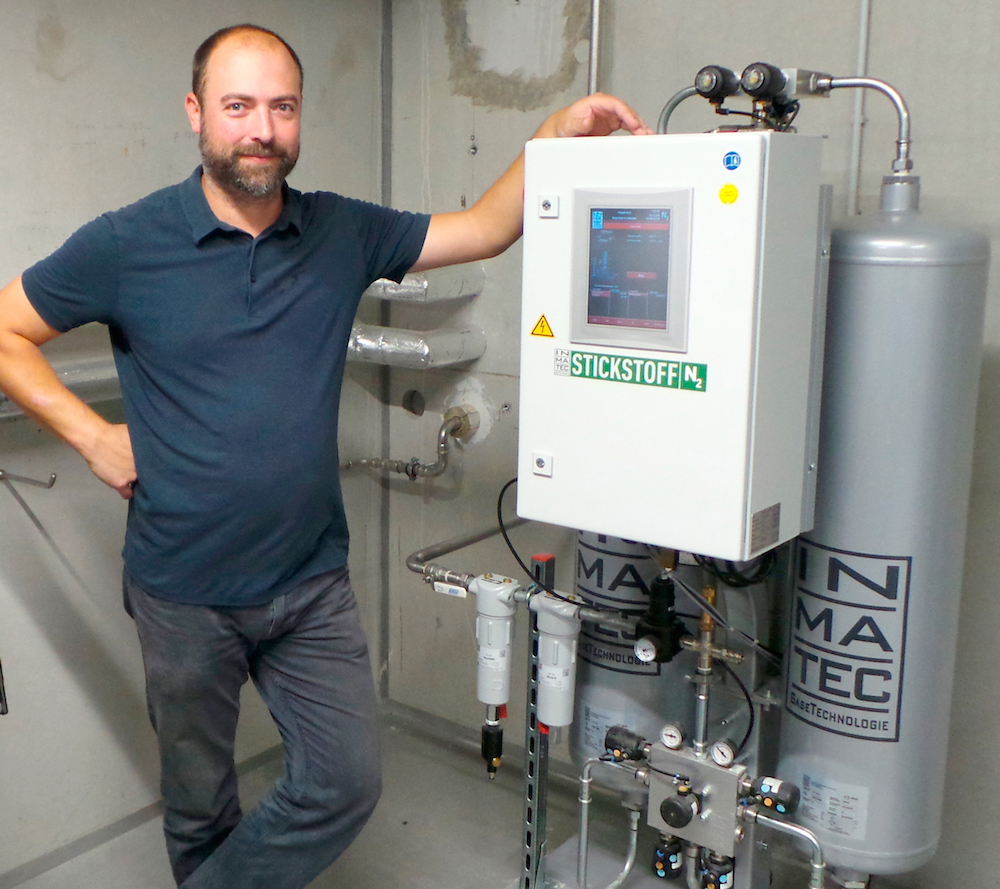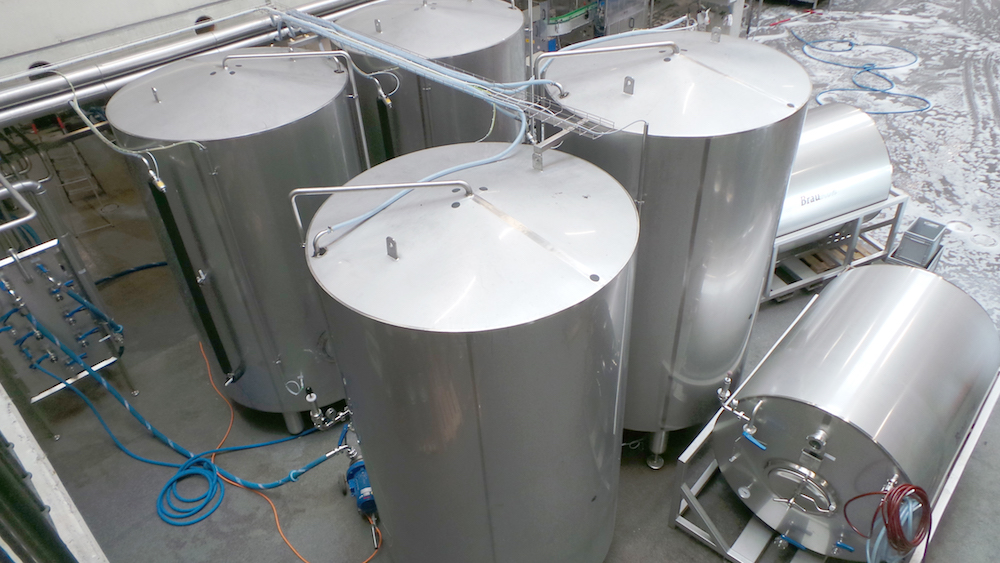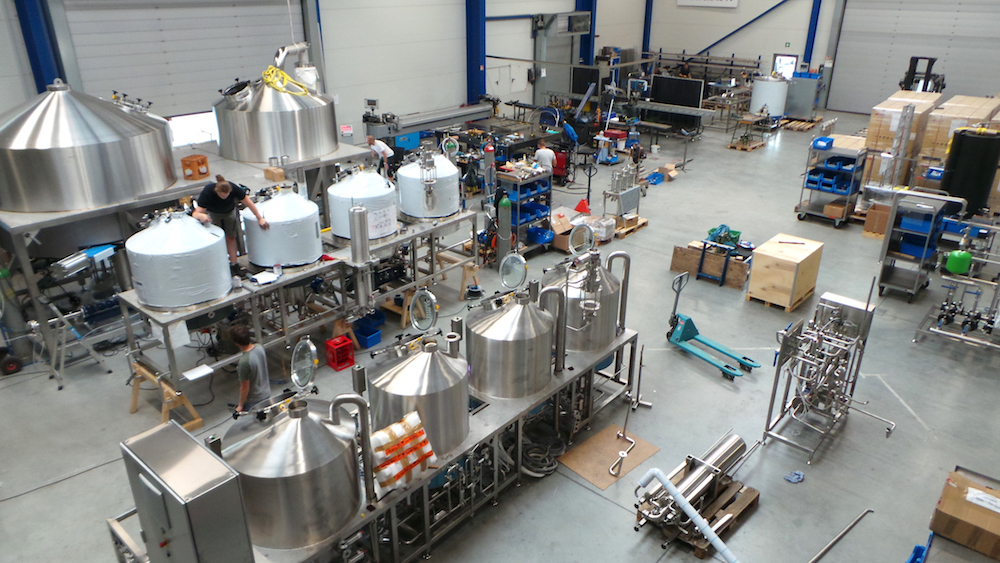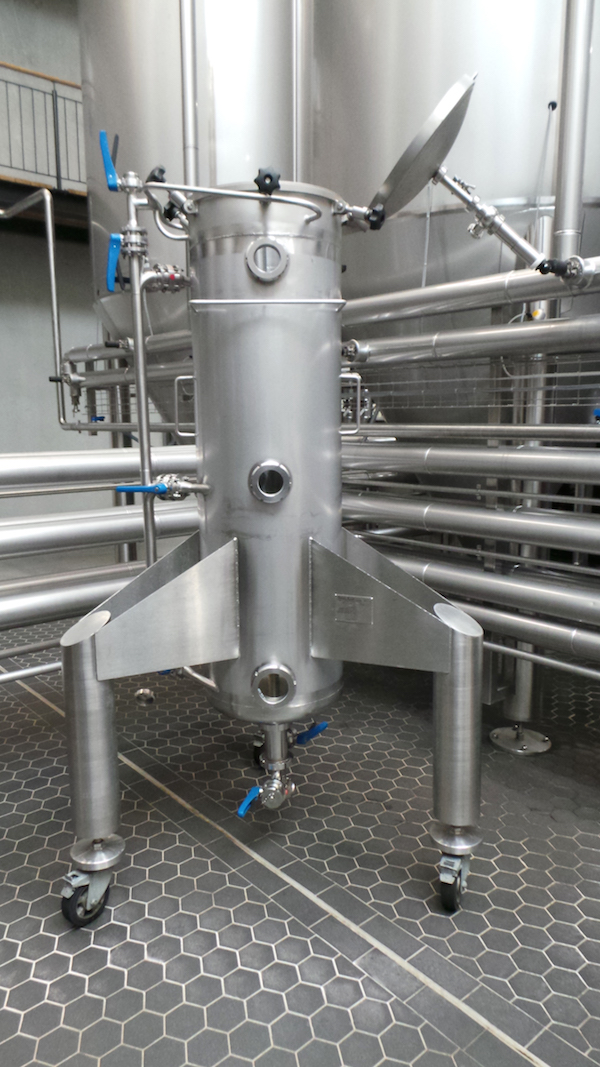Nitrogen is used in many food industries. Gas is also increasingly used in breweries to prevent beer spoilage and to keep it fresh for a long period of time. Bavarian company BrauKon, a manufacturer of brewing equipment and factories, has extensive experience using nitrogen and is familiar with industries in which the use of nitrogen offers breweries advantages over using carbon dioxide.
Several stages in the cooking process occur in the absence of oxygen and using inert gases. After storage of beer, any contact with oxygen should be avoided,  since infections by pathogenic microorganisms and oxidative enzymatic reactions lead to a loss of quality, a decrease in stability during storage and spoilage of beer. That is why, after storage, the finished beer is further processed in an inert gas, such as fermentative carbon dioxide. However, often, especially in small breweries, in the fermentation process, insufficient amounts of carbon dioxide are released for later use as an inert gas, as a result often you have to buy expensive CO2. Nitrogen (N2) as an alternative.
since infections by pathogenic microorganisms and oxidative enzymatic reactions lead to a loss of quality, a decrease in stability during storage and spoilage of beer. That is why, after storage, the finished beer is further processed in an inert gas, such as fermentative carbon dioxide. However, often, especially in small breweries, in the fermentation process, insufficient amounts of carbon dioxide are released for later use as an inert gas, as a result often you have to buy expensive CO2. Nitrogen (N2) as an alternative.
Nitrogen offers the brewery many advantages. For example, the release of nitrogen from atmospheric air using a generator allows the plant to produce the required amount of the most inert gas. This process is more cost-effective and environmentally friendly, since there is no need for gas delivery by tankers. In addition, a shortage of CO2 supplies can be avoided, as happened, in particular, in the summer of 2018, as well as production losses. Braukon GmbH employees know how and in which processes nitrogen can be used in a brewery.
 Located in Chiemsee, Bavaria, BrauKon is a manufacturer of brewery equipment and designs and supplies turnkey brewery startups worldwide, technology, and raw materials for the brewing process. In the BrauKon Technikum “laboratory”, more than 30 master brewers and engineers improve all industrial-grade products and from time to time test new processes for practical use. Brewing processes are also tested and optimized using various combinations of raw materials and mixed gas. In particular, the use of nitrogen was tested here at different stages of the cooking process. The results are also included in the production of Camba Bavaria, a subsidiary of BrauKon, which produces and distributes 16 different types of beer called Camba.
Located in Chiemsee, Bavaria, BrauKon is a manufacturer of brewery equipment and designs and supplies turnkey brewery startups worldwide, technology, and raw materials for the brewing process. In the BrauKon Technikum “laboratory”, more than 30 master brewers and engineers improve all industrial-grade products and from time to time test new processes for practical use. Brewing processes are also tested and optimized using various combinations of raw materials and mixed gas. In particular, the use of nitrogen was tested here at different stages of the cooking process. The results are also included in the production of Camba Bavaria, a subsidiary of BrauKon, which produces and distributes 16 different types of beer called Camba.
Nitrogen is used at various stages of the brewery process chain. In addition to carbon dioxide, Camba also uses nitrogen to create pre-pressure in beer tanks. In each of the sixteen 160 hectolitre tanks, a different type of beer is brewed. Such as traditional dark, light, March, wheat beer, international light beer and cherry ale bourbon, aged in oak barrels. The tanks are used as unit tanks, and after a week period of fermentation and secondary fermentation, the tank is cooled to 0 ° C for storage, and it lasts another four to six weeks. After fermentation, beer is served directly in transport tanks for trucks or in tanks for interim storage. “During decantation, it all depends on whether the tank is completely empty in one operation or if it is emptied in a few drains. If the tank is emptied over several drains, we use CO2 to create specific conditions for the carbon dioxide content in the beer. If, on the other hand, the tank is completely empty, nitrogen is fed into it from above under pressure to completely remove oxygen from it, ”explains master brewer Christoph Lippert-Pagani.
In this context, the carbon dioxide used is supplied to the system through small tanks located in the utility room. Tanks are delivered to Camba weekly by truck, totaling about 20 tons per year. The required nitrogen is produced directly on site.
INMATEC is a leading manufacturer of nitrogen generators from Germany.
The INMATEC generator, Germany's leading manufacturer of nitrogen generators, can produce up to 37 m3 of nitrogen per hour, depending on demand. The IMT BC 1450 PAN type nitrogen generator has a PSA technology, i.e. sterile compressed air passes through two adsorption vessels filled with a carbon molecular sieve. Molecules of oxygen and carbon dioxide from ambient air bind in a sieve, while free nitrogen molecules enter a product tank and an additional storage tank with a volume of 1,500 m3 in order to capture peaks. Dry nitrogen has a purity that meets the nutritional requirements of at least 95.5% and can now be used by Camba for a wide range of applications. According to brewer Lippert-Pagani, the nitrogen produced by the company has several advantages:
“This year we had some difficulties with the supply of CO2. We get our CO2 exclusively from natural underground deposits, which promise the highest gas purity.
However, the CO2 deficit due to reduced global fertilizer production has generated excessive demand. If the delivery arrives too late, we are stuck in terms of production. That is why we are very pleased that we ourselves can produce alternative nitrogen at our brewery. In addition, thanks to our own production, we save up to 60% of costs. ”
 When the fermentation or cooling tanks are empty, 15 m3 of the volume of each of them is filled under a pressure of 1.2 bar. Therefore, the generator must provide 18 m3 of nitrogen in a very short period of time. The transport and working tanks are cleaned before draining. To do this, they are first treated with steam for sterilization, and then filled with nitrogen in several stages to avoid any contact of beer with oxygen. When emptying the tank, they are again sealed with nitrogen. Spill is another area where N2 is used in breweries. At this stage of the process, carbon dioxide is no longer needed for beer carbonation, and, accordingly, purchased carbon dioxide can be completely replaced with nitrogen. Only in very large breweries does the removal of CO2 from the fermentation process make economic sense. At Camba, each bottle is filled with gas through an elongated tube on the carousel in a bottling plant. Then, during isobaric filling, beer enters the bottle, CO2 evaporates, and oxygen remains outside. At the final stage, the crown plug is placed on the bottle and the label is glued. Now the product is ready.
When the fermentation or cooling tanks are empty, 15 m3 of the volume of each of them is filled under a pressure of 1.2 bar. Therefore, the generator must provide 18 m3 of nitrogen in a very short period of time. The transport and working tanks are cleaned before draining. To do this, they are first treated with steam for sterilization, and then filled with nitrogen in several stages to avoid any contact of beer with oxygen. When emptying the tank, they are again sealed with nitrogen. Spill is another area where N2 is used in breweries. At this stage of the process, carbon dioxide is no longer needed for beer carbonation, and, accordingly, purchased carbon dioxide can be completely replaced with nitrogen. Only in very large breweries does the removal of CO2 from the fermentation process make economic sense. At Camba, each bottle is filled with gas through an elongated tube on the carousel in a bottling plant. Then, during isobaric filling, beer enters the bottle, CO2 evaporates, and oxygen remains outside. At the final stage, the crown plug is placed on the bottle and the label is glued. Now the product is ready.
“Today we are still using purchased CO2 to fill. However, soon we will completely switch to nitrogen for both bottling and kegs, not least to improve our CO2 balance, ”says Lippert-Pagani.
 Therefore, nitrogen can be used in many industries of the breweries. How and to what extent depends primarily on the processes of the brewery. “We supply INMATEC nitrogen generators with most of our turnkey brewing equipment. This trend is intensifying. From this point of view, the size does not depend primarily on the performance of the brewery. More important are the processes of the respective plant. We carefully study them together with our customers and install the appropriate generator, ”explains Lippert-Pagani. In addition, the need for nitrogen may also depend on the type of beer that is brewed. For some types of beer, the so-called hop making process with whole or chopped cones is used. BrauKon offers a specially designed and patented HopGun tank for this purpose. HopGun is filled with hop pellets and then washed with young beer from the tank. Flavors, dissolves, and hop essential oils give particular hoppy benefits to beers such as Camba Ho Gun, Camba IPA or Camba Hopla. Like all other tanks, Braukon HopGun is filled with 100% nitrogen for cleaning and inert extraction. Another special and individual use of nitrogen in a brewery. In addition, different countries have a different brewing culture. For example, in southern countries, less CO2 is often dissolved in beer. English breweries love to use stones for carbonating beer. CO2 and cost savings are playing an increasingly important role in many countries. All this affects the use of nitrogen in the brewing process.
Therefore, nitrogen can be used in many industries of the breweries. How and to what extent depends primarily on the processes of the brewery. “We supply INMATEC nitrogen generators with most of our turnkey brewing equipment. This trend is intensifying. From this point of view, the size does not depend primarily on the performance of the brewery. More important are the processes of the respective plant. We carefully study them together with our customers and install the appropriate generator, ”explains Lippert-Pagani. In addition, the need for nitrogen may also depend on the type of beer that is brewed. For some types of beer, the so-called hop making process with whole or chopped cones is used. BrauKon offers a specially designed and patented HopGun tank for this purpose. HopGun is filled with hop pellets and then washed with young beer from the tank. Flavors, dissolves, and hop essential oils give particular hoppy benefits to beers such as Camba Ho Gun, Camba IPA or Camba Hopla. Like all other tanks, Braukon HopGun is filled with 100% nitrogen for cleaning and inert extraction. Another special and individual use of nitrogen in a brewery. In addition, different countries have a different brewing culture. For example, in southern countries, less CO2 is often dissolved in beer. English breweries love to use stones for carbonating beer. CO2 and cost savings are playing an increasingly important role in many countries. All this affects the use of nitrogen in the brewing process.
“We clearly see the benefits of using nitrogen in a brewery. We are less dependent on suppliers and reduce costs annually. Saving CO2 in production and  reducing CO2 supplies to trucks, we can make our beer in a more environmentally friendly way and keep the region safe. The constant positive results that we get from the use of self-generated nitrogen in our brewery convinced us. This allows us to give the right advice to our worldwide customers, to whom we supply breweries with technology, and to support them during operation and in reducing CO2 emissions. The reliable and durable INMATEC nitrogen generators, which we can offer in the right sizes, play an important role here, ”says chief brewer Christoph Lippert-Pagani.
reducing CO2 supplies to trucks, we can make our beer in a more environmentally friendly way and keep the region safe. The constant positive results that we get from the use of self-generated nitrogen in our brewery convinced us. This allows us to give the right advice to our worldwide customers, to whom we supply breweries with technology, and to support them during operation and in reducing CO2 emissions. The reliable and durable INMATEC nitrogen generators, which we can offer in the right sizes, play an important role here, ”says chief brewer Christoph Lippert-Pagani.
Posted by Marcus Berniger Inmatec